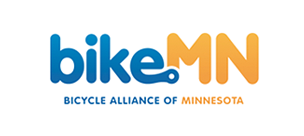By BikeMN Deputy Director angela olson
Riding an ebike can be exhilarating – the speed, the ease, the powerful feeling of the assist. In fact, the first time I rode an ebike I described it as “like riding on a pegasus!” If you would have told me when I first started commuting that I would be riding an ebike nearly every day, I would not have believed you. As a person who uses an ebike for most of my commuting and errands, I absolutely love it and feel passionate about sharing information with other potential riders.
However, along with the joys of ebike riding can come concerns. How different is riding an ebike from a non-electric bike? What about safety or speed? Do laws apply differently to ebikes? There are a lot of questions and some misinformation about ebikes and their safety or use. I hope this blog post can help clear up some misconceptions and empower you to choose the best bicycle for you and your body, whether ebike or not! Let’s break down some basics:
What is an ebike?
An ebike is any bicycle with either a built in or post production electronic motor that assists with your pedaling. The assist is not meant to replace your pedaling power, but enhance it. They come in three classes:
- Class 1 – an electric assist up 20MPH with NO throttle
- Class 2 – assist up to 20MPH WITH a throttle
- Class 3 – assist up to 28MPH with NO throttle
**Note, class 3 ebikes with a throttle do exist, but are technically an illegal class in Minnesota. Additionally, any modification that bypasses the speed control on an ebike not only voids your warranty, but is also not allowed.
What about safety?
Bike riding, like most physical activities or transportation methods, comes with some level of risk. Ebike riding is no different. A common concern is the speed. Since ebikes can get up to a higher speed faster than a non-electric bike, it could be easier to lose control if a rider hits a pothole or suddenly has to avoid a hazard especially if the rider is newer to biking. That is why, like with any vehicle, it is important to learn how ebikes work and take time to practice driving them. Another thing to practice when you first get your ebike is stopping since, at higher speeds, (just like in a car), it takes longer to come to a full stop. Luckily, BikeMN has Adult Education opportunities for anyone interested in learning more about biking.
Speed concerns are valid, but should be put in the correct context in comparison to cars. Speed has a direct impact on the risks of injuries/fatalities in crashes and cars cause about 40,000 deaths per year according to NHTSA
Batteries and the risk of fire come up as a concern as well. Lithium-ion batteries are found in our smartphones, laptops and ebikes/electric transportation. They have a lot of benefits, but do carry a small risk of fire. Buying ebike batteries from a reputable retailer with UL certification, getting the battery checked out if you’re in a crash, only using the appropriate charging cable, and charging in a clear, supervised place can all greatly reduce the risk of fires from an ebike battery. For context, close to 300,000 cars catch fire per year, according to the National Fire Protection Association.
Another common safety concern is trail usage, especially mixed-use trails and other infrastructure. I’ll go over that in the next section.
Bike laws:
In Minnesota, all bike drivers have the same rights and responsibilities as car drivers (except for the Stop-as-Yield or Safety Stop. To learn more about this check out our post here). Ebike drivers are no exception. There are certain areas/infrastructure that may have restrictions on the type of ebike allowed depending on the infrastructure, like:
LOCAL: Consult your local land management agency. (Different trail systems may restrict all, some, or none of new e-bike classes so check ahead and/or look for signage.)
STATE: Minnesota Department of Natural Resources allow Class 1 and 2 electric bicycles wherever traditional bicycles are allowed.
FEDERAL: The majority of public lands managed for recreation in Minnesota are under the jurisdiction of the U.S. Forest Service, where eMTBs are considered motorized vehicles and have access to motorized trails.
Additionally, all bike drivers (ebike and non) are required to adhere to speed limits posted on roadways and trails. Some other important ebike laws:
- You must be 15 or older to operate an ebike
- A driver’s license is not required to operate an ebike or non electric bicycle
- Modifying the ebike to bypass the speed limit control is not allowed
- On mixed use trails, bikers must alert pedestrians of their approach with a bell or their voice.
What else should you know?
Driving your ebike can be a fun, accessible, and easier way to get around. Ebike sales in the United States leaped by 269% between 2019 and 2022, so more people are using ebikes as a transportation method than ever. I’ll leave you with some other helpful links below:
Support safe biking, walking, and rolling in Minnesota
